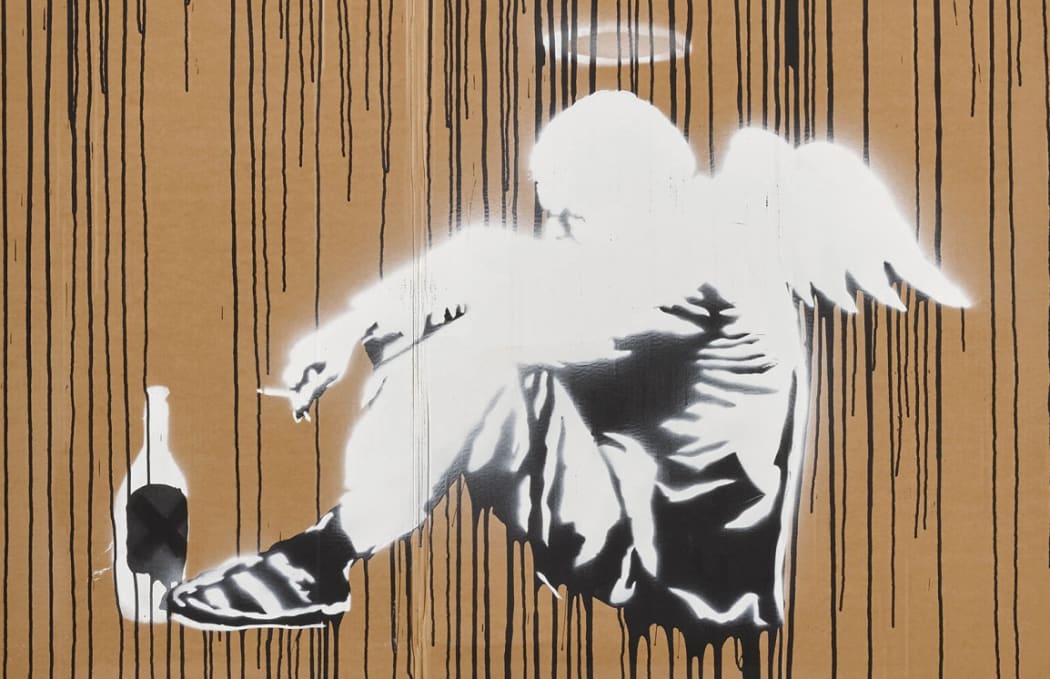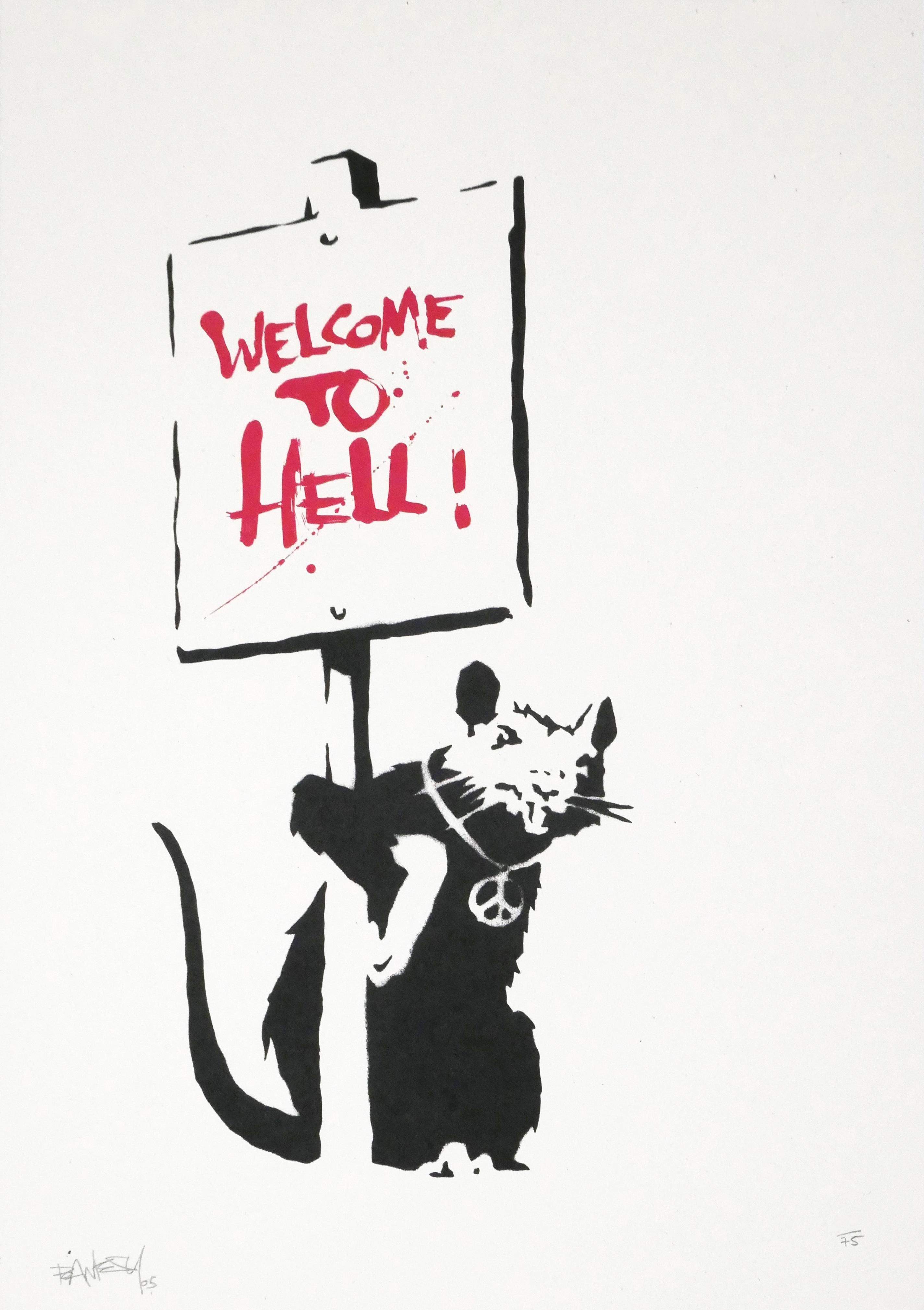
The earliest known Christian image of an angel, in the Cubicolo dell'Annunziazione in the Catacomb of Priscilla,can be dated to the middle of the third century. Winged angels and their carvings have existed in many expressions of Christian and Islamic art, notably taking root in Byzantine art. In Abrahamic religions angels can serve a dual purpose. A fallen angel is one who has ignored God’s will and has been cast down to earth as punishment and, conversely, angels can also be depicted as the paragon of virtue and of sacrifice. This juxtaposition is presented by Banksy in his own depictions of angels and of hell.
Dead Angel
Appearing in Old Street in 2007, Dead Angel was created as a tribute to English graffiti artist OZONE and overlays the famous Pulp Fiction work. The street piece was accompanied by a touching message on Banksy’s website, 'The last time I hit this spot I painted a crap picture of two men in banana costumes waving hand guns. A few weeks later a writer called Ozone completely dogged it and then wrote "If it's better next time I'll leave it" in the bottom corner. When we lost Ozone we lost a fearless graffiti writer and as it turns out a pretty perceptive art critic.’ Conjuring up images of Shakespeare’s Hamlet, the skull holding a ghostly cherub is clad in a bulletproof vest. Here we see an innocent life lost that longingly stares death in the face - resigned and at peace. Here death is seen as a release, and is treated as such. Offering a dignified sense of existence even in the afterlife.

Fallen Angel
In Fallen Angel we see the silhouette of a smoking male figure in tracksuit bottoms sat next to a bottle of alcohol. The unknown figure is presented in Banksy’s signature stencil style with a halo and angel wings whilst above the figure a broken cross drips and runs down the work. The defeated figure looks exhausted and downtrodden - pushed down by the weight of society and of expectation that is shown through the broken cross. A loss of innocence and sadness feel the scene as Banksy subverts the concept of angelic peace through this broken figure. Perhaps a commentary on society’s insistence on salvation that is often out of reach for many of its inhabitants.

From the angel wings in Flying Copper, we see how Banksy questions the importance of a central concept within society and order: the police. Here we have the contrast of a cartoonish acid rave smiley face with that of the more detailed and serious/photo-realistic body of the policeman. This juxtaposition creates a feeling of the uncanny and one wonders if, once again, Banksy uses the motif of an angel to highlight and ridicule what he sees as the tyranny within institutions and the role of both religion and the police in keeping society subservient.
Interestingly, Banksy’s presentation of Hell seems less damning than that of his heaven. The most obvious example of Hell can be found within the placard rat series and the artwork “Welcome to Hell”.
Welcome to Hell
Welcome To Hell is executed in Banksy’s typical black and white stencilled style and shows an upright rat holding a placard that reads “Welcome To Hell '' The message, written in pink or red, is the sole use of colour on the print. Wearing a necklace with a peace sign, the rat is engaging in a protest. Against whom do we wonder? Could it be against the ruling classes? Is the rat’s hell comment a suggestion that the underclasses, symbolised by the rat, are living lowly lives and on the verge of revolution? In the piece, cleverly told through, at first glance, simple imagery, Banksy’s typical wit and interest in social commentaries shines through to dramatic effect, and causes us to ask ourselves, are we living in the hell of our own creation?. Is Hell and thus its concept the motivating factor that drives the characters in Banksy's world to act/ Unlike his presentation of heaven, hell seems to be a driving force that propels action whereas heaven seems to be the punishment.

Napalm
When we think of “Hell on earth” perhaps the most obvious Banksy work is that of Napalm. If one had to choose a work that captures Banksy then Napalm would be a wise choice - humour, poignancy and cutting, barbed wit. A scintillating attack on commercialism and, specifically, American consumer culture, the work uses the famous and brutal image of Vietnamese girl Phan Thi Kim Phuc (taken by AP photographer Nick Ut) showing her injured and fleeing from a napalm attack. Holding her hand are two powerful symbols of consumerism - Mickey Mouse and Ronald Macdonald. Transforming these two characters, the work takes on a deeply sinister and disturbing tone as childhood and innocence are deeply subverted to create such intense juxtaposition. As collectors ourselves, we look for works that generate emotions and Napalm is such a work that touches and repulses all at once. Surely, even in the world of Banksy the death of a child is no less hell filled than in our real world.

So, just what is hell for Banksy? It seems to be the current society that we live in that is so deeply and wonderfully explored through his art. The power structures such as authority, war and institutions are presented in a way that makes us think of both heaven and hell. Banksy subverts the notion of an angelic heaven through presenting his figures as marginalised, downtrodden and lost. Gone is the innocence and peace that one associates with such heavenly beings and the angels presented by Banksy seem pained. Likewise, his depiction of hell is more cartoonish and less intense. As Jung said, “Death is drawing together two worlds, not an end. We are the bridge.” Banksy creates a bridge between his heaven and hell creating a subtlety in his depictions reminding us of how fragile the balance between the two at first distinct worlds can be.
For more information on our Banksy paintings for sale or to buy Banksy prints, contact Andipa via sales@andipa.com or call +44 (0)20 7581 1244. Alternatively, sell your Banksy print with Andipa or find out more about selling Banksy paintings and artworks.